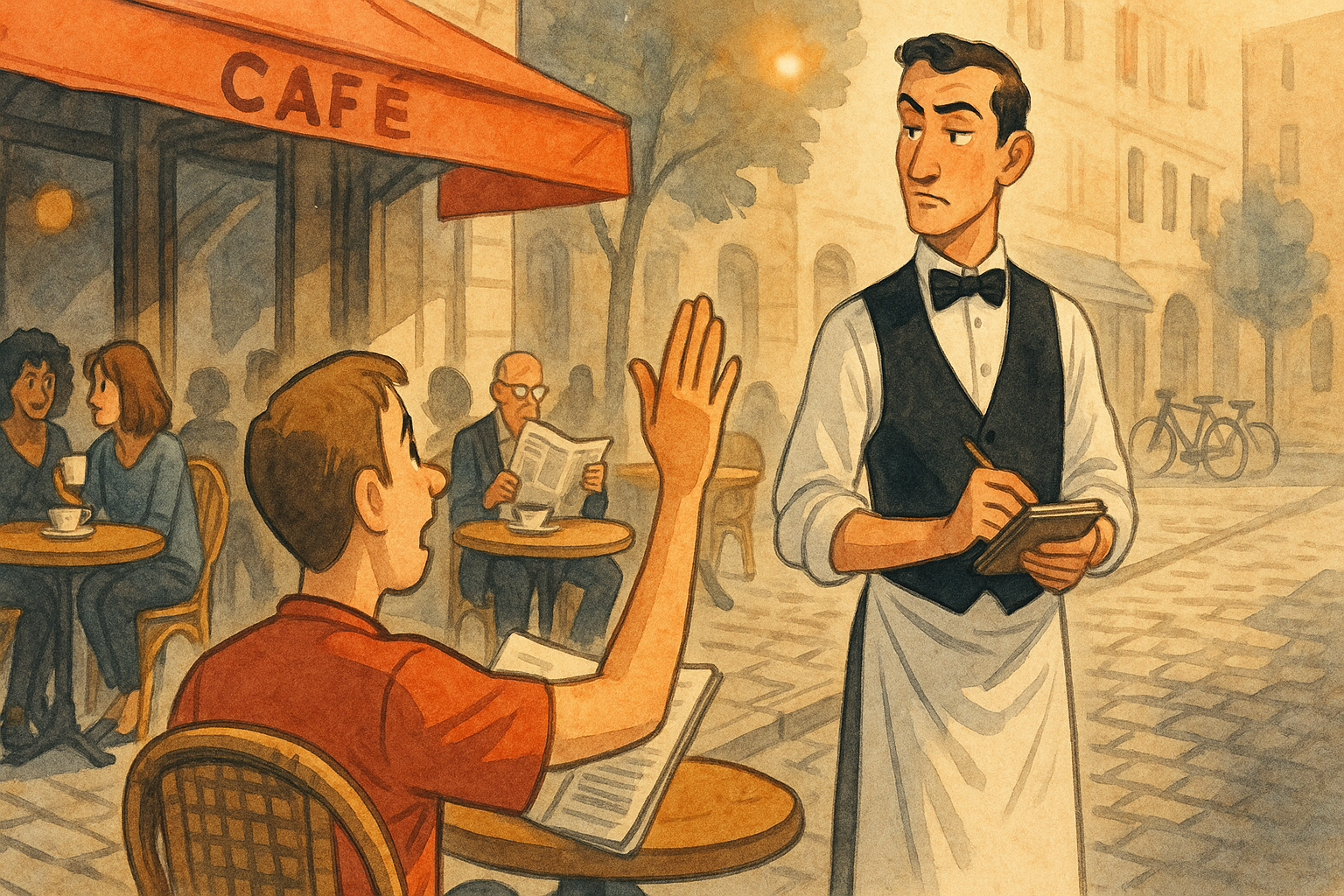French café culture — unwritten rules every tourist should know (A1–B1)
French café culture represents far more than coffee consumption—it embodies a distinct social institution with centuries of tradition, unwritten etiquette rules, and cultural significance that tourists frequently misunderstand. This comprehensive guide reveals the essential unwritten rules, proper ordering etiquette, pricing mysteries, and insider knowledge that transforms you from obvious tourist into respectful café patron.

Why French cafés are fundamentally different
American coffee shops optimize for speed and turnover—grab your coffee, find a seat if lucky, vacate quickly for waiting customers. Starbucks epitomizes this transactional model where coffee represents fuel for productivity rather than destination itself. French cafés operate on opposite principles: they sell time and space as much as beverages. The café functions as extension of living room, workplace, meeting spot, and social hub simultaneously.
This fundamental difference creates the most important unwritten rule: never rush in a French café. You’re not just buying a coffee—you’re renting territory for as long as desired. Order one espresso and occupy your table for three hours? Perfectly acceptable. Write your novel, read newspapers, watch people pass, engage in philosophical debates—all legitimate café activities that servers respect rather than resent.
Historical context explains this cultural difference. Parisian cafés emerged as crucial public spaces during Enlightenment, where intellectuals, artists, writers, and revolutionaries gathered for hours debating ideas that shaped Western thought. Café de Flore and Les Deux Magots hosted Sartre, Simone de Beauvoir, Hemingway, and Picasso not briefly but daily, often for entire afternoons. This intellectual café tradition persists today, maintaining spaces where contemplation, conversation, and observation hold equal importance to consumption.
The sacred pricing system — comptoir, salle, terrasse
Three prices for the same coffee
The system: French cafés charge different prices depending where you consume your drink:
- Au comptoir (at the counter): Cheapest option — stand at the bar, drink quickly, leave
- En salle (inside seating): Moderate price — sit at indoor table, stay as long as you want
- En terrasse (terrace/outside): Most expensive — prime real estate with street views and people-watching
Why this matters: The same espresso might cost €1.50 au comptoir, €2.50 en salle, and €4.50 en terrasse. You’re not paying for better coffee—you’re paying for space, service, and ambiance.
This tiered pricing system isn’t tourist exploitation but honest acknowledgment that different experiences merit different costs. Standing at the counter for two minutes versus occupying premium terrace real estate for two hours obviously provide different value propositions. The system allows everyone access—students can afford comptoir prices while tourists splurge on coveted terrace tables.
💡 Budget tip: Locals often drink their morning espresso au comptoir (standing at the bar) for €1-2, chatting briefly with the barista before continuing their day. This quick ritual costs a fraction of sitting down but provides authentic local experience.
Understanding the price board
Most cafés display a price board showing all three pricing tiers. Look for terms like “Tarifs” or “Nos Prix” with columns labeled “Comptoir,” “Salle,” and “Terrasse.” Always check prices before ordering to avoid bill shock when settling up. Tourist-heavy areas charge significantly more than neighborhood cafés—expect to pay double or triple near major attractions compared to residential arrondissements.
The essential ordering etiquette
Rule 1: Greet before ordering
Always say: “Bonjour” (or “Bonsoir” after 6pm) before stating your order. French culture prioritizes social acknowledgment over transactional efficiency.
Never do: Walk up and immediately bark your order without greeting. This marks you as rude foreigner faster than any accent.
🇫🇷 FR (WRONG) — Un café. ❌
Translation: A coffee. (Too abrupt, no greeting)
🇫🇷 FR (RIGHT) — Bonjour ! Un café, s’il vous plaît. ✅ /bɔ̃ʒuʁ œ̃ kafe sil vu plɛ/
Translation: Hello! A coffee, please.
Rule 2: Use polite conditional forms
Polite ordering: Use “Je voudrais” (I would like) or “Je prendrais” (I’ll take) rather than direct commands.
Even better: Phrase as question: “Est-ce que je pourrais avoir…” (Could I have…)
🇫🇷 FR — Bonjour ! Je voudrais un café crème, s’il vous plaît. /bɔ̃ʒuʁ ʒə vudʁɛ œ̃ kafe kʁɛm sil vu plɛ/
🇺🇸 EN — Hello! I would like a coffee with cream, please.
Rule 3: Wait to be seated (sometimes)
General rule: If staff presence is obvious, wait to be shown to a table. If the café appears self-service (common in casual spots), choose your own seat.
When unsure: Make eye contact with staff and wait for acknowledgment or gestural permission before sitting.
Rule 4: Understand coffee vocabulary
Critical distinction: “Un café” means espresso, not American drip coffee. If you want larger coffee with milk, order “un café crème” or “un café allongé.”
Essential café ordering phrases
🇫🇷 FR — L’addition, s’il vous plaît. /ladisjɔ̃ sil vu plɛ/
🇺🇸 EN — The check, please.
🇫🇷 FR — C’est pour emporter ou sur place ? /sɛ puʁ ɑ̃pɔʁte u syʁ plas/
🇺🇸 EN — Is it to go or for here?
🇫🇷 FR — Vous avez une table en terrasse ? /vuz‿ave yn tabl ɑ̃ tɛʁas/
🇺🇸 EN — Do you have a table on the terrace?
For more detailed café ordering phrases and pronunciation, see our comprehensive guide to café French.
What absolutely NOT to do in French cafés
Major faux pas that mark you as clueless tourist
- Don’t snap fingers or wave aggressively for service. Make polite eye contact and wait. French servers notice you but won’t rush over until ready.
- Don’t ask for the check immediately after finishing. Servers won’t bring it until requested—you’re welcome to stay indefinitely.
- Don’t sit at dirty tables. If a table hasn’t been cleared, it’s not available yet. Wait for cleaning or choose cleaned table.
- Don’t order “one coffee to share” between multiple people. Each person should order something if occupying a table.
- Don’t bring outside food or drinks. Obvious but occasionally violated rule that causes genuine offense.
- Don’t monopolize busy terrace tables during peak hours without ordering. While lingering is generally fine, social awareness applies during lunch rushes.
The laptop culture clash
American coffee shops welcome laptop workers occupying tables for hours. Parisian cafés tolerate this practice less enthusiastically, especially during busy periods. While not forbidden, using cafés as free offices violates the spirit of café culture as social space rather than workspace. If you must work, order regularly, avoid peak hours, choose larger cafés, and remain aware of social cues suggesting you should vacate for paying customers.
The sacred terrasse — understanding outdoor café culture
The café terrasse represents perhaps the most iconic image of Parisian life—wicker chairs facing the street, small round tables, people-watching under awnings while sipping tiny espressos. This outdoor café tradition carries its own etiquette and cultural significance beyond indoor seating.
Terrace seating psychology
Notice how terrace chairs face outward toward the street rather than inward toward your companion? This arrangement isn’t accidental—it facilitates the essential Parisian pastime of people-watching. Sitting side-by-side observing street life together forms an acceptable alternative to face-to-face conversation. Tourists initially find this arrangement odd but quickly appreciate the endless entertainment of watching urban theater unfold.
Weather resilience
Parisians occupy terraces year-round, defying weather with blankets, heat lamps, and enclosed plastic walls during winter. This commitment to outdoor café culture regardless of temperature demonstrates its cultural importance beyond mere dining preference. The terrace provides specific ambiance and social experience that indoor seating cannot replicate.
Prime terrace real estate
Corner tables offering maximum street visibility command highest desirability. Arrive early or be prepared to wait for coveted positions. Solo diners should expect to share larger tables during busy periods—the server may seat additional customers at your table if space allows. This practice, unthinkable in American dining culture, represents normal space optimization in Parisian cafés.
💡 Insider tip: Famous literary cafés like Café de Flore or Les Deux Magots charge premium prices for history and location. For authentic experience without tourist markup, seek neighborhood cafés in residential arrondissements like the 10th, 11th, or 20th.
Tipping etiquette and payment customs
The French tipping system
Service compris: Service charge is included in all prices by law. Your bill already includes server wages—tipping is optional, not mandatory.
Appropriate tipping: Round up to the nearest euro or leave small change (€0.50-2 for coffee, €5-10 for meals). This gesture acknowledges good service without the fifteen to twenty percent American expectations.
Never expected: Large percentage-based tips. Generous tipping can actually offend by suggesting the server needs charity.
Payment procedures
Unlike American restaurants where servers monitor tables for departure, French cafés require you to request the check explicitly. Say “L’addition, s’il vous plaît” when ready to leave. The server brings a small dish or folder containing the itemized bill. Review it, place payment inside, and wait for the server to return with change. Never leave payment on the table and walk out—this appears like you’re fleeing without paying.
🇫🇷 FR — Je peux payer par carte ? /ʒə pø peje paʁ kaʁt/
🇺🇸 EN — Can I pay by card?
Credit cards are universally accepted in Parisian cafés, though some neighborhood spots maintain cash-only policies. Always carry some cash as backup, particularly in smaller establishments or outside major cities.
Regional differences — Paris vs provinces
While this guide focuses primarily on Parisian café culture, regional variations exist throughout France. Southern France café culture embraces outdoor living even more enthusiastically than Paris, with terraces remaining packed until late evening during summer. Provence and Côte d’Azur cafés often merge with restaurant service more seamlessly than Parisian separation of café and bistro.
Northern France and smaller cities maintain more relaxed café atmospheres with less tourist pressure and lower prices. Lyon, Bordeaux, and Toulouse offer authentic café culture without Parisian intensity or cost. These provincial cafés often encourage more interaction between staff and regular customers, building neighborhood community feeling that Paris’s constant tourist turnover prevents.
The Parisian café personality
Parisian café servers cultivate a specific professional demeanor—efficient but not effusive, polite but not chatty, present but not hovering. This reserved service style strikes Americans as cold or rude, but it actually respects your privacy and autonomy. The server won’t interrupt conversations to check satisfaction repeatedly, won’t pressure you to order more, and won’t rush you to vacate. This hands-off approach allows you to enjoy your café experience undisturbed.
The art of flâner — purposeless wandering and café culture
The French concept of “flâner”—leisurely wandering without specific destination—connects intimately with café culture. After strolling through neighborhoods observing architecture, window shopping, and people-watching, the café provides natural pause point. You’re not interrupting your day to grab coffee; you’re integrating the café into the rhythm of urban exploration.
This approach transforms café visits from transactional coffee purchases into cultural experiences. Rather than targeting specific cafés from guidebooks, discover neighborhood spots organically while exploring areas like Montmartre. Choose cafés based on ambiance, available terrace seating, or simply where your wandering leads. This spontaneous approach aligns with French appreciation for serendipity over rigid planning.
Famous Parisian cafés and their histories
Café de Flore (Saint-Germain-des-Prés)
Opened in 1887, Café de Flore became the intellectual headquarters of existentialism. Jean-Paul Sartre wrote there daily during the Nazi occupation when his apartment lacked heating. Simone de Beauvoir, Albert Camus, and Pablo Picasso gathered regularly. Today it remains elegant but expensive, charging premium prices for its literary heritage. Expect to pay €10+ for coffee on the famous terrace.
Les Deux Magots (Saint-Germain-des-Prés)
Competitor and neighbor to Café de Flore, Les Deux Magots attracted Hemingway, James Joyce, and Bertolt Brecht. The café awards an annual literary prize maintaining its intellectual prestige. Like Flore, it now caters primarily to tourists seeking literary pilgrimage, with prices reflecting its fame rather than its coffee quality.
Café de la Paix (near Opéra Garnier)
This opulent Second Empire café designed by Charles Garnier offers stunning Belle Époque interiors and terrace views of the Palais Garnier. Its gilded mirrors, painted ceilings, and historical grandeur create theatrical café experience worth the elevated prices for special occasions.
💡 Local alternative: Instead of famous tourist cafés, try neighborhood favorites like Café Charlot in the Marais, La Palette near École des Beaux-Arts, or any unmarked corner café where locals actually drink. Authenticity and value increase dramatically away from guidebook recommendations.
Seasonal café culture variations
Summer café life
Terraces expand dramatically during warm months, often encroaching significantly onto sidewalks. Evening café culture thrives as Parisians linger outdoors until late, enjoying apéro (pre-dinner drinks) and extended conversations. Summer brings intense competition for terrace tables during peak hours—arrive early or accept indoor seating.
Winter café comfort
Enclosed heated terraces create cozy winter sanctuaries with blankets provided for outdoor sitting. Interior cafés develop intimate atmosphere as condensation fogs windows and radiators create warmth. Hot chocolate (chocolat chaud) replaces iced drinks as preferred beverage. Winter café culture emphasizes refuge from weather, transforming cafés into cocoons of comfort.
Study glossary — café culture vocabulary
| FR | IPA | EN |
|---|---|---|
| Un café | /œ̃ kafe/ | An espresso |
| Un café crème | /œ̃ kafe kʁɛm/ | Coffee with cream |
| Un café allongé | /œ̃ kafe alɔ̃ʒe/ | Americano (espresso + water) |
| Un noisette | /œ̃ nwazɛt/ | Espresso with drop of milk |
| La terrasse | /la tɛʁas/ | Outdoor seating area |
| Le comptoir | /lə kɔ̃twaʁ/ | The bar/counter |
| L’addition | /ladisjɔ̃/ | The check/bill |
| Le pourboire | /lə puʁbwaʁ/ | The tip |
| Flâner | /flɑne/ | To wander leisurely |
| Le serveur / La serveuse | /lə sɛʁvœʁ / la sɛʁvøz/ | Waiter / Waitress |
| Un verre | /œ̃ vɛʁ/ | A drink (glass) |
| L’apéro | /lapeʁo/ | Pre-dinner drinks |
Authoritative references
- France.fr — official guide to Parisian café culture.
- Time Out Paris — contemporary café recommendations and culture.
Learn French with Roger, Native French Tutor
Expert instruction with proven teaching methods. Personalized lessons tailored to your goals from A0 to C1.
Weekly Lessons with Roger
Learn with Roger, a native French tutor. Structured curriculum from beginner to advanced.
- Native French speaker from France
- All levels (A0-C1) supported
- Personalized curriculum
- Proven teaching methodology
Trial Lesson with Roger
Experience Roger’s teaching method with a 25-minute trial session. Perfect to get started.
- 25 minutes with Roger
- Level assessment included
- Personalized learning roadmap
- No commitment required
A1 Foundations Guide
Complete beginner’s guide created by Roger. Structured lessons with native pronunciation.
- Step-by-step A1 curriculum
- Audio by native French speaker
- Practice exercises included
- Learn at your own pace
Continue Learning
Check out these related articles

French pronunciation & listening (A1–B1) — liaison, rhythm, real-life comprehension
French listening becomes easier when you trust the music of the language—smooth connections, gentle stress, and quiet vowels—so in this…

French restaurant booking phrases (A0–A2) — reserve, arrive, order
french restaurant booking phrases help you secure a table, arrive smoothly, and start the meal with confidence. This A0–A2 guide…

How long does it really take to learn French? — realistic timeline for English speakers (A1–B2)
Discover realistic timelines for learning French as an English speaker, from beginner to fluent, with CEFR milestones, study hour estimates,…
👋 Join Our Community
Follow us for daily tips, pronunciation tricks, and free resources
👍 Follow on Facebook